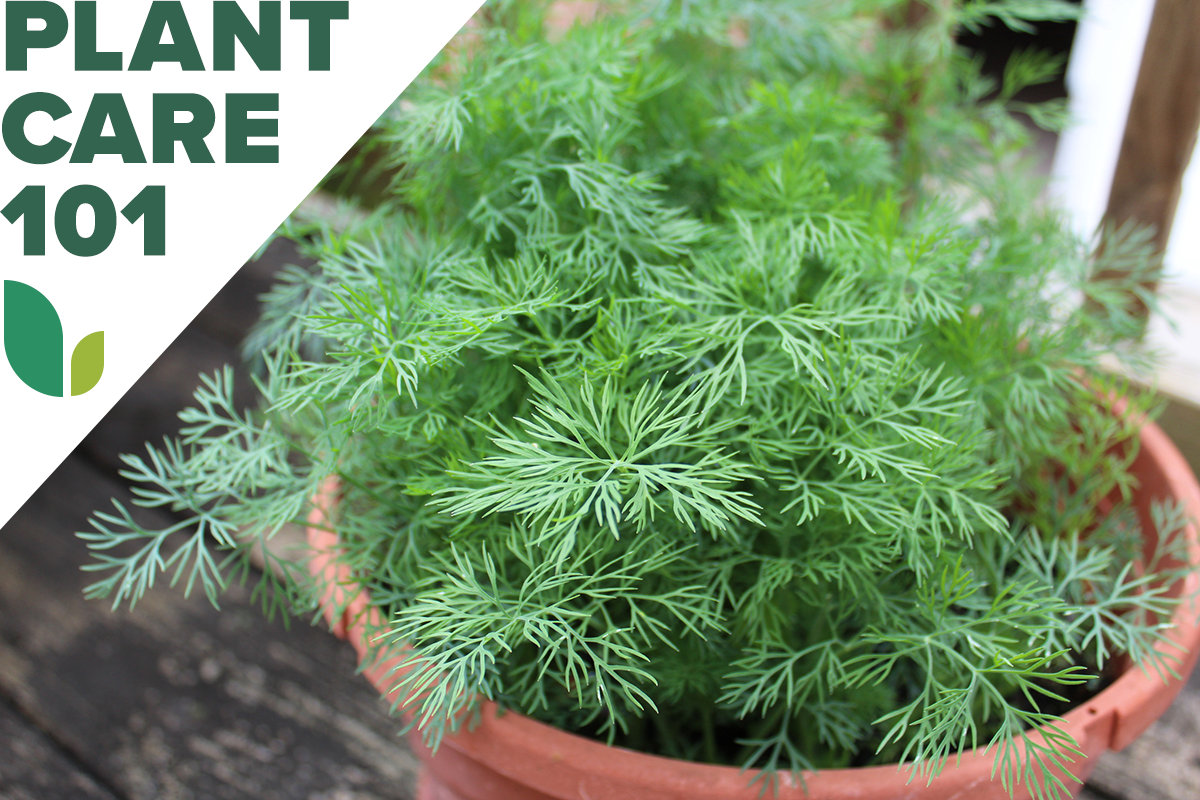We may earn revenue from the products available on this page and participate in affiliate programs. Learn More ›
Dill’s foliage, usually called “dill weed,” spices up fish dishes and salads, nurtures the larvae of the black swallowtail butterfly, and makes a ferny filler for bouquets. So even if you aren’t a fan of dill pickles, there are reasons you may want to find out how to grow dill.
Growing Dill at a Glance
Common Name: Dill
Scientific Name: Anethum graveolens
Hardiness Zone: Annual
Soil: Well drained, moderately fertile
Light: Full sun
Water: Medium
Food: Low-nitrogen organic fertilizer
Propagation: Seeds
Safety: Edible, but it can cause phytophotodermatitis
Dill Characteristics
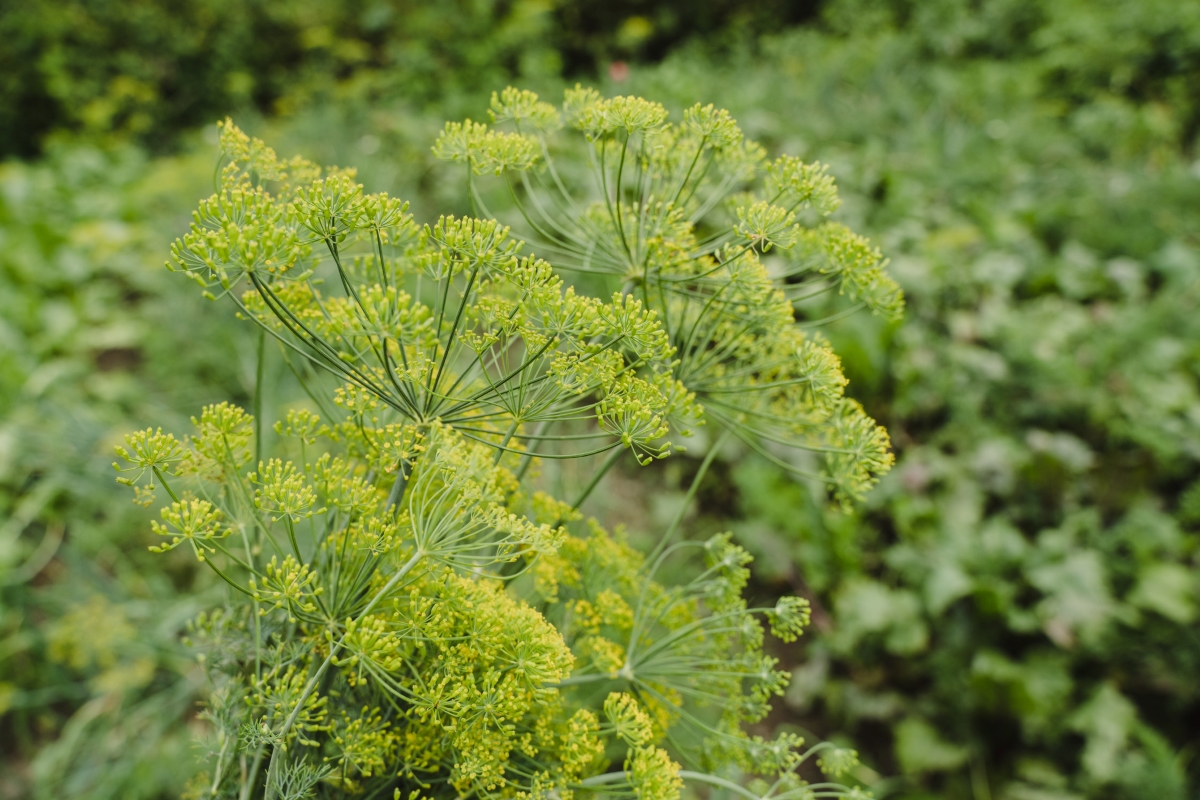
A dill plant typically grows 3 to 4 feet tall, though the robust ‘Hercules’ variety can reach 5 feet. An annual in the carrot family, the herb resembles Queen Anne’s lace, with ferny foliage and 6-inch clusters of small blooms. However, the flowers of dill are yellow rather than white. Because the outdoor herb self-sows heavily, it too has naturalized in some part of the U.S.
If your dill weed becomes infested with black, white, and yellow caterpillars, you may want to carefully move them to Queen Anne’s lace plants instead of destroying them. They are likely larvae of the black swallowtail butterfly, which favor members of the carrot family.
Dill makes a good companion plant for cucumbers—and not only for the obvious reason that both are delicious for pickling. When used in companion planting, dill helps you garden organically on a shoestring by attracting beneficial insects.
Recommended Dill Varieties
When selecting dill seeds for planting, keep in mind whether you are growing them mainly for their seed or for their weed.
- ‘Bouquet’: The most popular variety, this one grows to 3 feet and offers an abundance of flowers and seeds.
- ‘Fernleaf’: Topping off at about 18 inches and slow to bolt (go to seed), this cultivar is good for containers and can offer a continuing supply of dill weed.
- ‘Hercules’: For even more dill weed, try this herculean type, which reportedly can grow to 5 feet.
Planting Dill
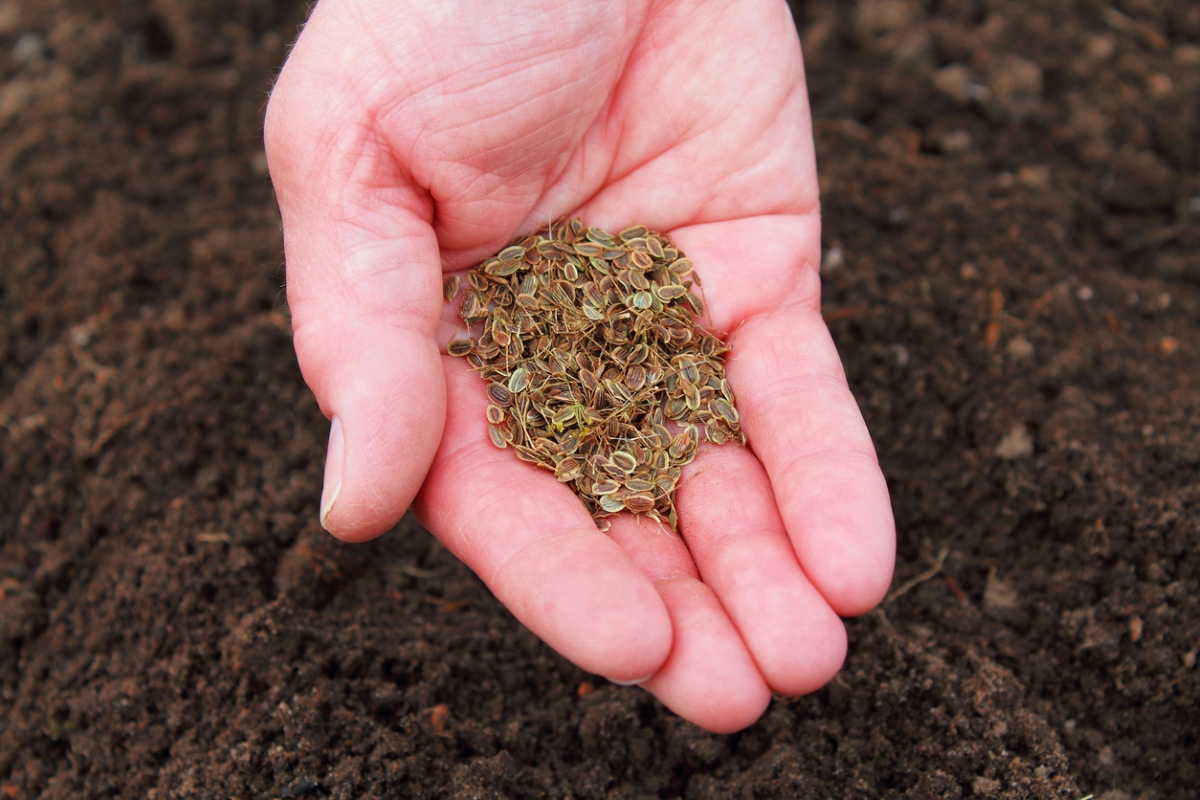
Because dill seedlings don’t transplant well, you should sow them directly into the ground if possible.
When is the best time to plant dill?
When growing dill from seed, sow the seed when temperatures reach between 60 and 65 degrees Fahrenheit during the day, perhaps about 2 weeks before your last frost date. Mature plants reportedly will tolerate light frosts, but you’ll probably want to protect newly emerging dill seedlings from freezing temperatures, if any should occur during that time period.
Where can dill grow?
Choose a location in full sun with only moderately fertile soil for growing dill, as overly fertile conditions tend to dilute the flavor of herb plants. That ground should have a pH between 5.8 and 6.5. Select a site that is sheltered from the wind since dill has hollow stems and can be easily damaged by strong gusts.
How do you plant dill?
You may want to make new plantings every 2 weeks or so to ensure a continuing supply of dill weed.
- When planting dill, use your hoe handle to make a furrow ¼ inch deep in the soil.
- Scatter your seeds along that furrow and cover them to a depth of ¼ inch.
- After they have germinated, which can take 7 to 21 days, and grown to 2 inches, thin the plants by snipping off extra seedlings so that the remaining ones stand at least 1 foot apart with 2 feet between rows.
Can you grow dill in containers?
When growing dill in pots, remember that it has long roots, and be sure to choose a container for it that’s at least 1 foot deep. Because some cultivars can grow up to 5 feet, it’s also a good idea to opt for one of the shorter types, such as ‘Fernleaf’, which shouldn’t surpass 18 inches in height.
Watering Dill
Dill requires only the same medium amount of water favored by most of the rest of your vegetable garden—about 1 inch per week. If possible, use drip irrigation rather than the overhead type to prevent fungus issues. Once your plants reach 6 inches in height, you may also want to apply 2 to 3 inches of mulch to keep the soil evenly moist and suppress weeds. After the plants have set seeds, they will tolerate drier conditions than they would earlier in their growth cycle.
Fertilizing Dill Plants
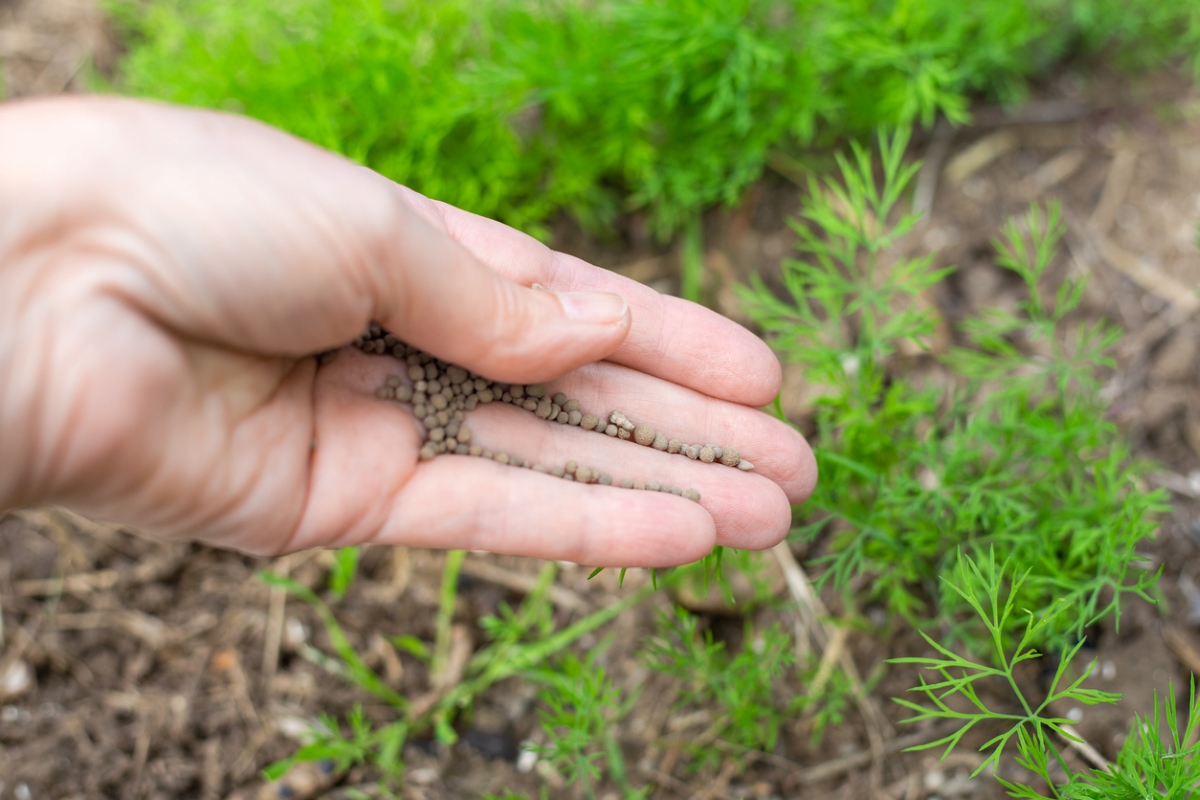
Herbs such as dill should not be fertilized heavily as overly lush growth tends to have inferior flavor. Instead, feed them only once a year in late spring, using 1 cup per 10 square feet of a low-nitrogen organic fertilizer (such as 4-6-3) and working it into the top 6 inches of soil. For containers, you may want to opt for a low-nitrogen organic liquid fertilizer (such as 2-4-2) applied at half strength only once per month.
Pruning Dill
Dill doesn’t require pruning. However, if you are growing the plant for its foliage rather than its seeds, you’ll want to snip off any developing flower heads. Once the plant has reached its goal of producing seeds, it will stop growing. If you keep the flowers pruned off, however, it won’t be able to make those seeds and should keep putting out tender new dill weed for you. You can also use this method to delay the production of seeds until you are ready to use them.
Safety Considerations
Dill is nontoxic to both people and their pets. In fact, it is sometimes used to relieve indigestion. However, contact with chemicals in the foliage may cause phytophotodermatitis in some people.
According to the Mayo Clinic, “when these chemicals get on your skin and then are exposed to ultraviolet light, a chemical reaction occurs that often looks like a sunburn, or it may develop as a red, itchy patch, similar to eczema.” For this reason, it’s a good idea to keep your skin covered when you are in the vicinity of dill, just in case.
Potential Pests and Diseases
Because dill attracts tomato hornworms, it numbers among the trap plants often used to lure those pests away from tomatoes. Hand-picking is the best way to dispose of those worms.
When it’s overwatered, dill also can suffer from powdery mildew, which resembles white dust on the foliage. You can help prevent that fungal disease by only watering moderately and keeping your plants spaced widely enough apart to allow plenty of air circulation around them.
Harvesting Dill
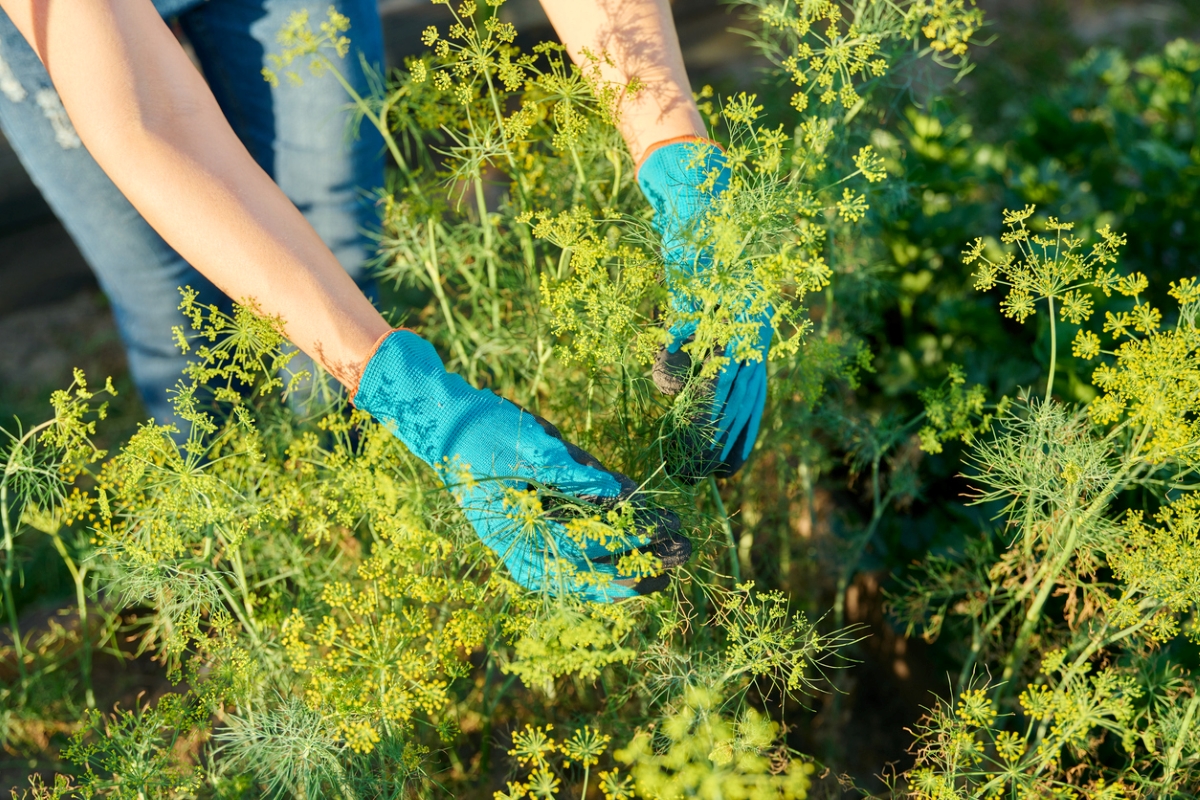
Because contact with dill can cause phytophotodermatitis in some people, it’s a good idea to wear long sleeves and gloves while gathering it.
When is the best time to harvest dill?
When harvesting dill weed, keep in mind that the best flavor occurs just before or at the beginning of dill plant flowering. To harvest fresh dill seeds for pickles, cut the seed heads 2 to 3 weeks after the plants have finished blooming, just when the seeds are beginning to turn from green to tan.
How do you harvest dill?
Keep in mind that preserved dill weed doesn’t retain its flavor well. However, frozen dill weed reportedly keeps its flavor a little better than dried dill weed.
- To harvest dill weed or seed heads to dry, cut the dill in the early morning and string it up in an airy, protected location.
- Tie paper bags over the seed heads to catch the seeds after they dry and fall off.
- Once the dill is dry, discard the stems before storing the foliage.
- Alternatively, freeze dill weed in ice cubes or inside zipped freezer bags.
How do you store dill?
Store dried dill weed or dried dill seeds to plant in airtight containers in a cool, dark location. Keep in mind that dill weed that’s been frozen often will turn dark in color. It usually retains its flavor best if it’s used to spice food that doesn’t require cooking or if it’s added after the food has been cooked.
Looking for more beginner-friendly herbs? Check out our guides on growing catnip, hops, and mint.

